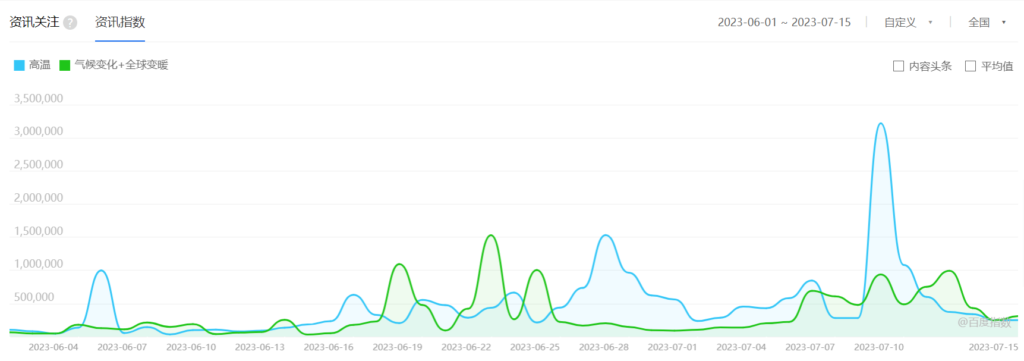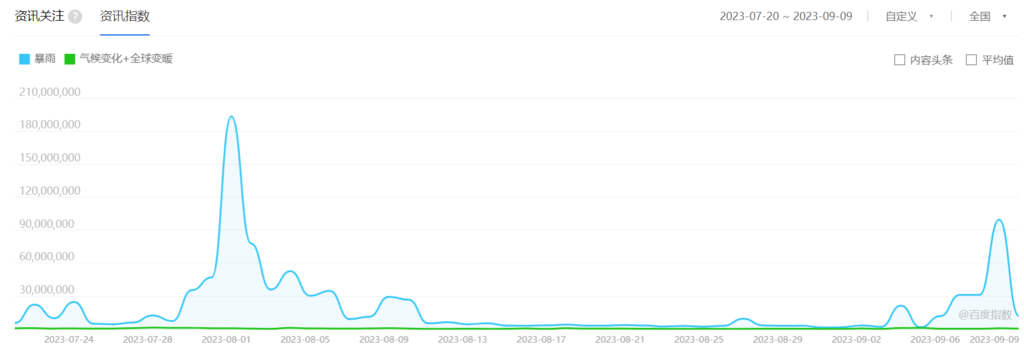Taking the Pulse – Summer 2023 Newsletter
For a PDF of this newsletter, please click here.
In Focus: Did extreme weather advance the climate discussion in the Chinese media?
It was a challenging summer for many regions in China. Heatwaves, typhoons, storms, and floods…extreme weather events occurred one after another, testing society’s resilience in every dimension.
Beijing was on the front line. The capital city recorded its hottest June day in over 60 years, reaching 41.1°C. Just a few weeks after experiencing a prolonged heatwave, Beijing received the heaviest rainfall in 140 years, which led to 33 deaths.
Globally, climate change is becoming more salient in media coverage of extreme weather, thanks to increased climate awareness and advances in attribution science. Is there a similar trend emerging in China?
There is no easy answer to that question. Our observations of Chinese media coverage of heatwaves and rainstorms point to two very different pictures. Using a trend analysis tool provided by Chinese tech giant Baidu, we can see a correlation between heatwaves and climate change (or global warming), both in terms of search queries and content generated online. But this is not the case for rainstorms.
The chart below presents the Baidu Index from June 1st to July 15th of the keywords “high temperature” (blue line) and “climate change or global warming” (green line). The index takes consideration of a range of factors including the volume of related content generated, and the number of viewers, comments, and interactions. The higher the index is, the more popular the topic is. In China, high temperature days are defined as those with maximum daily temperature above 35°C, and three or more consecutive days of high temperature constitute a heatwave. To many Chinese reporters and readers, global warming is the term that they are more familiar with, so the analysis considers both terms – climate change and global warming.
Chart 1: Baidu Index – “high temperature” (blue) and “climate change or global warming” (green)

Chart 1 shows that during the periods when “high temperature” became more popular as a news topic, searches for climate change also rose. However, the curves were not perfectly correlated. The peak of the blue line around July 10th was triggered by the World Meteorological Organization’s news release on the hottest week on record.
The second chart shows the Baidu Index from July 20th to September 9th of the keywords “rainstorm” (blue line) and “climate change or global warming” (green line). The index for rainstorm is much higher than that for climate change or global warming, which means rainstorm, as a news topic, received a lot more media attention.
Chart 2: Baidu Index – “rainstorms” (blue) and “climate change or global warming” (green)

The peak of rainstorm-related news coverage occurred at the beginning of August, when historic rainfalls took place in Beijing and its neighboring cities, causing disastrous floods. In September, Hong Kong and southern China were hit by record-breaking rainfall, which created another spike in media attention. However, despite the high volume of coverage about rainstorms in absolute terms, this did not seem to have an effect on the salience of climate change or global warming. Most coverage focused on the damage and rescue efforts, without looking into how climate change might increase the frequency or severity of similar extreme events.
In summary, it appears the role of climate change in extreme weather is more closely linked to heatwaves than rainstorms or other types of extreme events in Chinese media coverage. This does not come as a surprise, since the attribution science about heatwaves is the most robust, and to regular readers, the link between high temperature days and global warming is more intuitive.
Coming back to the question raised at the beginning of this newsletter, we think China’s media discussion about extreme weather is taking baby steps toward higher awareness of climate risks. Chinese scientists are also becoming more vocal, sending warnings and conducting attribution studies at greater speed, which is encouraging.
In addition to connecting the dots between extreme weather and climate change, some experts also called for building resilience across different sectors of society, including in the power system, infrastructure, and urban planning. We present some of their opinions and commentary in the following section.
Nevertheless, these steps are far from enough to convey the urgency of climate adaptation and mitigation, or to boost public support for climate actions. But there is an opportunity – personal experiences with extreme weather events are driving larger numbers of people to ask whether they are becoming more frequent. Building on that intuition and turning it into awareness of climate impacts and resilience against risks will require joint efforts from the climate community in China and beyond.

Flood discharge in Beijing. Photo credit: The Paper
Quotes and opinions
Extreme weather and climate risks
- “Between June 22nd and 24th, the mean maximum temperature for three consecutive days in June in the North China region reached its highest value in the historical record since 1959. In a quick attribution research exercise on this extreme heat event, our team found that human-induced climate change had increased the intensity of extreme heat by more than 1°C. Compared to climatic conditions without the influence of human-induced climate change, the probability of similar record-breaking high-temperature events occurring under current climatic conditions has significantly increased by approximately threefold, with an increase of about 1.0°C in intensity.”
– Qian Cheng and his research team, Institute of Atmospheric Physics, Chinese Academy of Sciences
- “Beijing reported the heaviest rain in 140 years in the beginning of August. As the frequency of extreme weather events continues to rise, concerns mount as to whether the ecosystem that humans depend on has reached a new equilibrium. The global scientific community has indicated the existence of approximately 16 to 17 critical thresholds in our ecosystem, with at least half of them nearing the tipping point. One extreme weather event might be mitigated by prevention and mitigation measures. However, if we are facing a new equilibrium in which “extreme” becomes the new normal, how shall humanity tackle it?”
– Xu Xiaonian, President of China Meteorological Service Association
- “For more than a decade, terms like ‘hottest summer ever’ have frequently appeared. This year, the temperature has reached new record highs. The high temperature with relatively low precipitation in June will be recorded as part of the history of extreme weather in Beijing. When climate change passes a certain threshold, it leads to fundamental changes and becomes more and more tangible.The root cause of extreme heat lies in global warming. The systematic risks of global climate change are universal, unpredictable, and endogenously correlated. Extreme heat is just one facet of the issue. The ‘disaster package’ brought by global warming also includes torrential rains, floods, droughts, wildfires, stronger typhoons, ocean acidification, sea level rise, etc. In essence, humanity has entered an era marked by frequent disasters.”
– Wei Ke, Associate Researcher of Institute of Atmospheric Physics, Chinese Academy of Sciences
- “In the past, northern China had a mainly dry climate, and many cities in the region, with dense population, had relatively underdeveloped infrastructure to handle extreme rainstorms. The combined effects of urban ‘heat islands’ and ‘rain islands’ further intensify the frequency and severity of heavy rains. Consequently, northern cities are highly exposed and extremely vulnerable to the risks brought by strong rainfalls.Based on our model’s predictions, there will be an evident increase in annual precipitation in China in the future. In the north, for example, from 2026 to 2045, urban regions in Beijing-Tianjin-Hebei will experience an increase not only in summer precipitation but also in annual average precipitation. There will also be more torrential rains, more days of moderate and heavy rainfalls, a greater number of rainy days and an increase in maximum consecutive five-day precipitation. As urban areas expand, the risk posed by heavy rainfalls continues to expand as well.”
– Chao Qingchen, Director general of National Climate Centre, China Meteorological Administration
Climate resilience, adaptation, mitigation
- “Climate modeling shows that without the influence of human activities and the condition of global warming, there is an extremely low probability that unprecedented extreme weather events, like the torrential rains in Zhengzhou in July 2021, would take place. The attribution of these extreme weather events needs specific analysis, and scientific conclusions need to be based on a large number of research results. However, it should be noted that such extreme events are indeed becoming more frequent and intense.Until global carbon neutrality is achieved, the situation ahead will certainly be more severe and challenging. The first thing we must do now, from my perspective, is to ensure early warning and prevention against extreme events. As global warming intensifies, its impacts grow, which we must manage to minimize.”
– Zhai Panmao, Co-Chair of Working Group I, IPCC; Researcher at Chinese Academy of Meteorological Sciences
- “Research shows that each year, approximately one million people in China die due to air pollution-related causes. In the future, as air quality continues to improve, the incidence of diseases related to air pollution, such as respiratory and cardiovascular illnesses, will significantly decrease. In contrast, the health impacts of climate change are rapidly increasing. According to the ‘China Lancet Countdown Report’ in 2021, around 25,000 people in China died due to heatwaves, which is double the number compared to the 1980s and 1990s. Therefore, we should pay close attention to the health effects of climate change and expedite decoupling of economic development from fossil fuel use in order to prevent the health damage caused by short-term air pollution and long-term climate change.”
– Cai Wenjia, Professor, Department of Earth System Science, Tsinghua University
- “China’s urbanization has taken place rapidly within a short period of time. Much of our urban construction has been influenced by traditional practices and knowledge, which may not necessarily align with today’s climatic conditions. In China’s national planning and construction, we may still be adhering to some norms and standards rooted in the thoughts of 1960s-1980s to guide large-scale infrastructure development. Therefore, we face a significant challenge in adapting to the changing climate effectively.”
– Liu Daizong, East Asia Director, Institute for Transportation & Development Policy
- Beijing Daily Commentary: The unpredictability of natural disasters underscores the need for relentless effort to build resilient cities. One of the significant aspects of this “resilience” is to effectively improve a city’s operational capacity in the face of extreme situations by setting scientifically grounded defense standards. For a long time, nearly all cities have tended to prioritize emergency response to prevention. However, even so-called “accidental” events may follow regular patterns in prediction and response. In every facet of urban planning, construction, operation, and management, it is essential to build a multi-level awareness network based on a comprehensive consideration of potential risks, thus ensuring that cities are proactive in the face of risks and disasters.
Thank you for reading!
In you have any questions, please contact:
Ms. Zhe Yao, yaozhe@igdp.cn
Mr. Diego Montero, diego@igdp.cn
